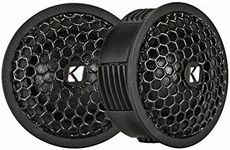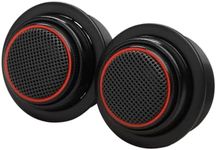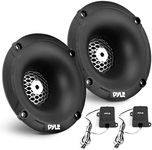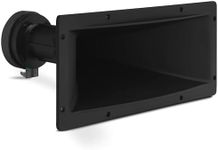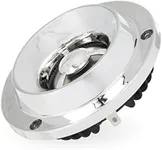Buying Guide for the Best Car Tweeters
Choosing the right car tweeters can significantly enhance your car audio experience by providing clear and crisp high-frequency sounds. Tweeters are small speakers designed to reproduce the upper range of the audio spectrum, typically from 2,000 Hz to 20,000 Hz. When selecting car tweeters, it's important to consider several key specifications to ensure they meet your audio preferences and fit well with your existing car audio system.Frequency ResponseFrequency response refers to the range of frequencies that a tweeter can reproduce. This spec is important because it determines how well the tweeter can handle high-frequency sounds. A wider frequency response range means the tweeter can produce a broader spectrum of high notes. Typically, tweeters have a frequency response starting from around 2,000 Hz up to 20,000 Hz or higher. If you enjoy music with a lot of high-pitched instruments or vocals, look for tweeters with a higher upper limit in their frequency response.
SensitivitySensitivity measures how efficiently a tweeter converts power into sound, usually expressed in decibels (dB). This spec is important because it affects how loud the tweeter will be at a given power level. Tweeters with higher sensitivity (above 90 dB) will produce more sound with less power, making them a good choice if you have a lower-powered car audio system. If you have a powerful amplifier, you might not need to prioritize sensitivity as much.
Power HandlingPower handling indicates the amount of power a tweeter can handle without being damaged, usually given in watts (W). This spec is important to ensure that the tweeter can handle the power output of your car audio system. There are two values to consider: RMS (continuous power handling) and peak power handling. RMS is more important as it represents the power the tweeter can handle continuously. If you have a high-powered system, look for tweeters with higher RMS ratings to avoid damage and distortion.
ImpedanceImpedance is the resistance a tweeter offers to the electrical current from the amplifier, measured in ohms (Ω). This spec is important because it affects the compatibility with your car audio system. Common impedance values for tweeters are 4 ohms and 8 ohms. Ensure that the impedance of the tweeters matches the specifications of your amplifier or head unit to avoid issues with sound quality and performance.
MaterialThe material of the tweeter's diaphragm affects the sound quality and durability. Common materials include silk, textile blends, and metals like aluminum or titanium. Silk and textile blends tend to produce a smoother, more natural sound, while metal tweeters can deliver brighter and more detailed highs. Choose the material based on your sound preference: if you prefer a softer, warmer sound, go for silk or textile; if you like crisp and sharp highs, metal tweeters might be the better choice.
Mounting OptionsMounting options refer to the different ways you can install the tweeters in your car. This spec is important for ensuring that the tweeters fit well in your vehicle and can be positioned for optimal sound quality. Common mounting options include surface mount, flush mount, and angle mount. Surface mounts are easier to install but may be more visible, while flush mounts provide a cleaner look but require more installation work. Angle mounts allow you to direct the sound towards the listener for better audio experience. Choose the mounting option that best fits your installation skills and aesthetic preferences.






